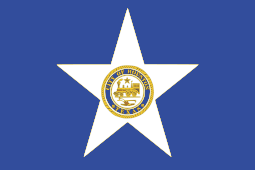This article needs additional citations for verification. (February 2024) |
 | |
| Proportion | 1:2 (official) 17:30 (usage) |
|---|---|
| Adopted | 1915 |
| Design | A blue field with the Seal of Houston in the center of a 5-pointed star in the middle of the flag |
| Designed by | W. A. Wheeldon |
The flag of Houston, Texas consists of a large white five-pointed star on a blue background with the city's seal set within the star. The flag was adopted in 1915.
In 1915, Mayor Ben Campbell decided Houston should have its own flag and organized a contest to solicit submissions from the public. According to a Houston Post clipping from 1915, one design idea included an illustration of Houston as a meteor, "the head of the star of which was plowing its way through a sky of equal proportions of red and blue."
The winning design was submitted by Major W.A. Wheeldon, a British ex-pat. The design, drawn by Mrs. J.W. Greenhill Jr., originally depicted the coat of arms of Sam Houston's family. A panel of contest judges, however, substituted the city seal for the coat of arms, saying it was more forward-looking.
The city seal was adopted in 1840, not long after the city was founded by Augustus Chapman Allen and John Kirby Allen. It depicts a 4-4-0 locomotive, although it was before any railroad reached Houston. According to John Lienhard, a professor emeritus of mechanical engineering and history at the University of Houston said the 4-4-0 locomotive featured prominently on the seal had only been around for three years at that point.[1]
This flag is not very popular or displayed commonly. The flag violates basics of flag design defined by the North American Vexillological Association as, keep it simple; use meaningful symbolism; use two to three basic colors; do not use lettering or seals; be distinctive or be related.
In 2015, an original 1915 prototype for what would become the official flag was found in a resident's garage and was given to Preservation Houston. Eventually, the group raised $3,500 to have the flag restored. The North American Vexillological Association kicked in the remainder of the cost with a $500 grant. The flag was sent to be restored in New Orleans and now hangs in the Julia Ideson Library downtown.[citation needed]
- ^ No. 2515, Houston and the Railways. Engines of our Ingenuity